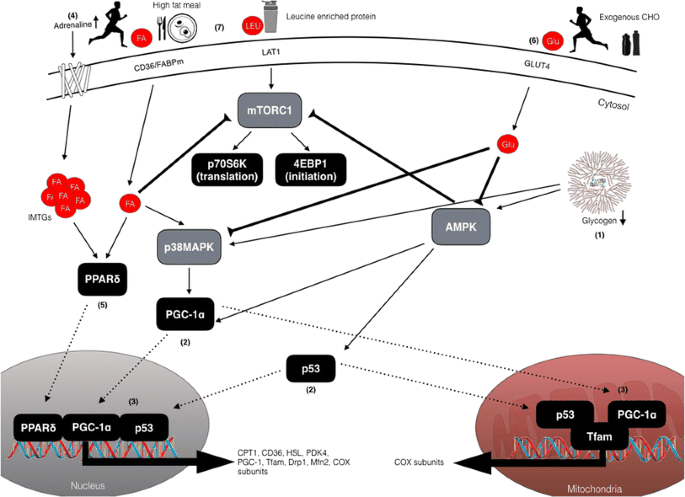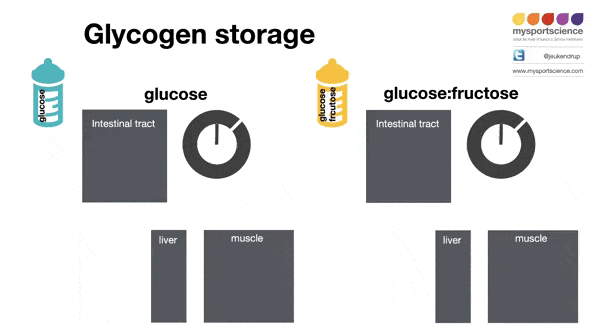The Incredible Power of Glycogen
Glycogen is the name given to the storage form of carbohydrates within the body. Tucked away within the muscle and liver, glycogen plays a hugely significant role in athletes performance. Here are 10 key things you should know about Glycogen as an athlete…
From Track Cycling to Boxing to Triathlon. For sporting events lasting anything from a few minutes up to a few days, your Glycogen is a vital fuel source.
High Performance Fuel - When exercising above around 60% of our VO2 max (anything of a moderate intensity and above), glycogen starts to be used as the predominant fuel source (as illustrated by the blue shading on the graph bars below). With increasing exercise intensity our reliance on glycogen as a fuel source increases to the point where at very high intensities (i.e. threshold/FTP) we are almost entirely dependent on glycogen as a fuel (1). As such, without glycogen, we don’t have the fuel or the ability to perform at high intensities.
This study (1) as nicely illustrated in this great infographic from Dr Jorn Trommelen https://www.nutritiontactics.com illustrates the different rates of fuel utilisation at different exercise intensities.
Finite Reserves - Whilst our bodies have an almost limitless supply of fat to use as a fuel (even a relatively lean athlete has 100,00kcal + of fat reserves, enough for days worth of exercise), our glycogen reserves are much more finite. When fully topped up Glycogen stores equate to somewhere in the region of 1600-2800kcal (400-700grams of carbohydrate), enough for just a few short hours of high intensity exercise. Most glycogen is within the muscles, whilst we also have around 60-90grams in the liver.
This graph gives some perspective on the difference between Glycogen and Adipose (fat) stores within the body (2).
Glycogen, Endurance Capacity & Exhaustion - A huge number of research studies over the past 100 years have demonstrated that our exercise capacity (i.e. how long we can exercise for before we fatigue) is directly related to how much glycogen we have stored in our muscle when we start exercise. Equally, lots of research has demonstrated that fatigue/nosedives in performance, generally coincide with our glycogen stores reaching critically low level.
This graph from a recent paper (3) shows that with increasing carbohydrate intake (Low, Medium & High Carbohydrate intakes) our exercise capacity increases.
Glycogen, Hydration & Body Weight - For every gram of carbohydrate we store as glycogen, we also store ~3grams of water (4). This makes glycogen a relatively poor energy store, as it takes up a huge amount of room and adds significant weight. As a result of this, changes in the amount of glycogen we have stored within our bodies, can have a quite a large impact on our weight. Going from having depleted glycogen stores to fully topped up glycogen stores can add as much as 2-3kg to an athletes body weight. Conversely a couple of hours of hard training/competition that depletes glycogen stores, can result in a similar amount of weight loss. Changes in Glycogen status can also explain why dieters who cut out carbohydrate from their diets see rapid changes in their body weight in quite a short space of time.
More training = more glycogen storage - One of the key ways that our bodies adapts to endurance training is to increase our storage of muscle glycogen. As such, highly trained athletes have a much greater capacity for glycogen storage compared to a relatively untrained athlete and this at least partially explain why better trained athletes can generally train harder for longer than less trained athletes.
This graph (5) shows the Glycogen stores within the muscle at different states and athletic abilities.
Glycogen and Training Adaptation - This one is truly mind blowing! With scientists now able to look at how the muscles respond to exercise at the gene level, we now know that muscle glycogen status can influence the genes that are expressed from our muscle as a result of training stress. Research from the past ~10yrs has shown that our glycogen affects how our muscles respond to exercise. Completing some training session with low muscle glycogen (often referred to as training low/fasted training) can lead to a greater amount of certain training adaptations compared to completing the exact same session with high glycogen stores. This effectively means that just by manipulating your carbohydrate intake before, during and after training can lead to more bang for your buck from your training.
Researchers can now look at how the muscle responds to session at a gene level. The complex diagram on the left illustrates some of these genes that are expressed as a result of manipulations of training and diet (6).
Dietary Carbohydrate & Glycogen - You may have already guessed this, but the amount of carbohydrate we consume in our diet has a direct influence on the glycogen in our muscles. The more carbohydrate you eat, the more our glycogen stores fill up, up to a point. This is why when we are looking to perform at key event we often look to carbohydrate load prior to it(7).
Glycogen under a microscope. The darker the shade, the more glycogen present. Each of the individual shapes represents a muscle fibre.
Exercise, carbohydrate intake and glycogen - Research has demonstrated that consuming carbohydrate during exercise can help preserve our glycogen stores, delaying the point at which it reaches reach critically low levels and negatively impacts on performance. This is particularly the case for liver glycogen, which is responsible for looking after our blood glucose (8). This helps our bodies to maintain our blood glucose later into exercise and helps explain why consuming carbohydrate during exercise can help improve performance.
Glycogen & Recovery - After a session how quickly we can restore our glycogen can have a big impact on our performance in subsequent sessions, particularly if there is little recovery between them. The total amount of carbohydrate we consume, the timing of it’s consumption and the type of carbohydrate we consume, all influence how our glycogen stores are replenished (9). From full depletion full recovery of glycogen to resting levels can take up to 48hours.
This graphic from Prof Asker Jeukendrup (https://www.mysportscience.com ) shows how using a blend of carbohydrates (glucose and fructose) can lead to greater glycogen storage in the liver.
Environmental Extremes & Glycogen Use - Alongside factors such as gender, habitual diet, fat burning capacity and exercise intensity, exercising in environmental extreme’s can have a big influence on glycogen utilisation. Both extremes of hot and cold can lead to a greater utilisation of glycogen and faster depletion (10,11).
So, now you hopefully understand the significance of Glycogen as an athlete a bit better, you might be wondering how we measure it and how to work out how much we use for a given training session/competition? This is where things start to get a bit complex. To accuracy calculate the amount of glycogen within the muscle, we need to cut out a small tube of the muscle out using a pretty big needle before freezing it and completing a chemical analysis. As the video below from Prof Graeme Close at Liverpool John Moore’s University shows, this is highly invasive technique, requires expert training and isn’t really a great experience for the athlete (almost no study in elite athletes has been completed using this technique).
Whilst there has recently been some interest around the use of ultrasound to assess muscle glycogen, as yet this doesn’t appear to provide sufficient accuracy, so we’re left waiting for a accurate and reliable noninvasive method for measurement (12). In the mean time, a skilled sports nutritionist looking at the demands of a session and the athlete diet can extrapolate data from previous research to estimate glycogen use and status. Another reason to work with an experience sports nutrition practitioner.
References
van Loon LJ, Greenhaff PL, Constantin-Teodosiu D, Saris WH, Wagenmakers AJ. The effects of increasing exercise intensity on muscle fuel utilisation in humans. J Physiol. 2001;536(Pt 1):295-304. doi:10.1111/j.1469-7793.2001.00295.x
Gonzalez JT, Betts JA, Thompson D. Carbohydrate Availability as a Regulator of Energy Balance With Exercise. Exerc Sport Sci Rev. 2019;47(4):215-222. doi:10.1249/JES.0000000000000196
Hearris MA, Hammond KM, Seaborne RA, et al. Graded reductions in preexercise muscle glycogen impair exercise capacity but do not augment skeletal muscle cell signaling: implications for CHO periodization. J Appl Physiol (1985). 2019;126(6):1587-1597. doi:10.1152/japplphysiol.00913.2018
Olsson KE, Saltin B. Variation in total body water with muscle glycogen changes in man. Acta Physiol Scand. 1970;80(1):11-18. doi:10.1111/j.1748-1716.1970.tb04764.x
Hearris, M. A., Hammond, K. M., Fell, J. M., & Morton, J. P. (2018). Regulation of Muscle Glycogen Metabolism during Exercise: Implications for Endurance Performance and Training Adaptations. Nutrients, 10(3), 298. https://doi.org/10.3390/nu10030298
Impey SG, Hearris MA, Hammond KM, et al. Fuel for the Work Required: A Theoretical Framework for Carbohydrate Periodization and the Glycogen Threshold Hypothesis. Sports Med. 2018;48(5):1031-1048. doi:10.1007/s40279-018-0867-7
Hawley JA, Schabort EJ, Noakes TD, Dennis SC. Carbohydrate-loading and exercise performance. An update. Sports Med. 1997;24(2):73-81. doi:10.2165/00007256-199724020-00001
Gonzalez JT, Fuchs CJ, Betts JA, van Loon LJ. Liver glycogen metabolism during and after prolonged endurance-type exercise. Am J Physiol Endocrinol Metab. 2016;311(3):E543-E553. doi:10.1152/ajpendo.00232.2016
Maunder E, Podlogar T, Wallis GA. Postexercise Fructose-Maltodextrin Ingestion Enhances Subsequent Endurance Capacity. Med Sci Sports Exerc. 2018;50(5):1039-1045. doi:10.1249/MSS.0000000000001516
Haman F, Péronnet F, Kenny GP, et al. Effect of cold exposure on fuel utilization in humans: plasma glucose, muscle glycogen, and lipids. J Appl Physiol (1985). 2002;93(1):77-84. doi:10.1152/japplphysiol.00773.2001
Fernández-Elías VE, Hamouti N, Ortega JF, Mora-Rodríguez R. Hyperthermia, but not muscle water deficit, increases glycogen use during intense exercise. Scand J Med Sci Sports. 2015;25 Suppl 1:126-134. doi:10.1111/sms.12368
Routledge HE, Bradley WJ, Shepherd SO, et al. Ultrasound Does Not Detect Acute Changes in Glycogen in Vastus Lateralis of Man. Med Sci Sports Exerc. 2019;51(11):2286-2293. doi:10.1249/MSS.0000000000002052
Thank you for reading!










